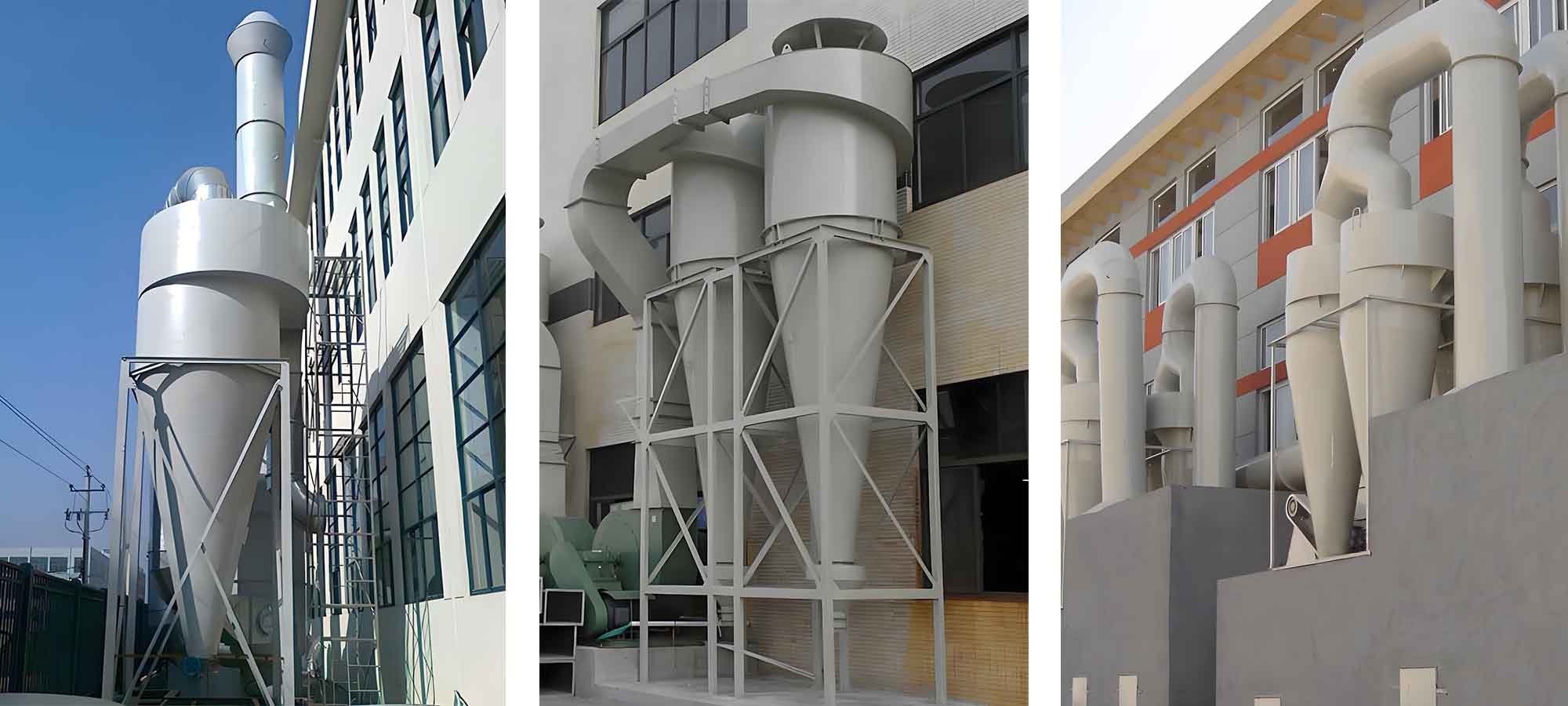A cyclone filter plays a crucial role in air pollution control. Each component has specific dimensional ratios. Any change in these ratios can significantly impact the collector’s efficiency and pressure loss. Key factors influencing performance include the diameter of the collector, the size of the inlet, and the diameter of the outlet pipe. Exceeding certain limits can turn beneficial factors into harmful ones. Additionally, while some adjustments can enhance dust collection efficiency, they may also increase pressure loss. Therefore, a balanced approach is essential.
1. Inlet Design of a cyclone filter
The inlet is a critical component of the cyclone filter. It creates the swirling airflow necessary for dust separation. The area of the tangential inlet greatly affects both dust collection efficiency and pressure loss. A smaller inlet area relative to the collector’s cross-section increases the tangential velocity, aiding dust separation.
2. Cylinder Diameter and Height
The diameter of the cylindrical section is a fundamental dimension of the cyclone filter. The tangential velocity of the rotating airflow inversely affects the centrifugal force on dust particles. At the same tangential velocity, a smaller cylinder diameter creates a shorter rotation radius, increasing the centrifugal force on the particles, which makes them easier to capture. Thus, selecting a smaller cylinder diameter is beneficial. However, if the diameter is too small, it may lead to particle escape or clogging, especially with viscous materials.
For larger airflow volumes, using multiple cyclone filters in parallel is an effective solution. The total airflow processed equals the sum of each collector’s capacity, while the resistance is based on the individual collector handling its portion of the airflow. However, parallel configurations can complicate manufacturing and increase material requirements. They may also lead to gas blockages, increasing resistance. Therefore, limiting the number of parallel units is advisable.
The total height of the cyclone filter is the sum of the cylindrical and conical sections. Increasing this height enhances the number of revolutions the airflow makes within the collector, increasing the chances for dust separation. However, it may also allow fine particles to enter the inner vortex, reducing efficiency. A typical height-to-diameter ratio of around 4:1 for the cylindrical section is recommended.
The conical section, with its decreasing radius, continually increases the tangential velocity of the airflow. This design typically improves dust collection compared to the cylindrical section. Thus, within a fixed total height, increasing the conical section’s height can enhance separation efficiency. Generally, a cylindrical height of 1.5 times its diameter and a conical height of 2.5 times the diameter yields optimal results.
3. Outlet Pipe Design
The diameter and insertion depth of the outlet pipe significantly affect dust collection efficiency. Choosing the right outlet pipe diameter is crucial. Reducing the outlet pipe diameter can shrink the internal vortex’s rotation range, making it harder for dust to escape. However, this increases the outlet velocity and pressure loss. Increasing the outlet pipe diameter may reduce pressure loss but can cause a “short-circuit” effect, allowing uncollected dust to enter the outlet. A recommended outlet diameter is 0.5 to 0.6 times the cylinder diameter.
The insertion depth of the outlet pipe is also critical. If inserted too shallow, dust-laden air may bypass the collector, reducing efficiency. If inserted too deep, it can increase friction losses and create opportunities for dust re-entrainment. The ideal depth is just below the inlet’s bottom.
4. Considerations for Combined Units
When combining cyclone filters, ensure uniform distribution of dust-laden airflow. The inlet, hopper, and outlet zones must remain strictly separated, with no leaks at the connections. Poor operational management, such as hopper leaks or delayed dust discharge, can severely impact efficiency and accelerate wear on the cyclone, shortening its lifespan.
Depending on the use conditions, different materials can be used to construct the cyclone filters, including steel, organic plastics, fiberglass, cast iron, and cast steel. Specialized linings can enhance durability against abrasion.
When linking cyclones in series, place lower-performance units downstream and higher-performance units upstream. Generally, avoid using identical cyclone models in series unless in high-concentration scenarios.
5. Continuous Improvement
To achieve low resistance and optimal performance, cyclone filter designs are continuously improved. Key modifications include:
- Changing Inlet Design: Switching from tangential to rotational inlets optimizes dust concentration distribution and reduces short-circuiting.
- Increasing Unit Count: Moving from a single to multiple units effectively reduces eccentric airflow and significantly lowers resistance.
- Adding Dust Discharge Channels: Installing discharge channels on the cylindrical and conical sections prevents dust from re-entering the airflow.
- Implementing Secondary Separation Devices: Adding devices like reflective screens or intermediate hoppers helps prevent dust re-entrainment.
- Enhancing Outlet Design: Installing secondary separators at the outlet improves the collection of fine dust, utilizing the strong rotational flow of exhaust air.
- Incorporating Resistance-Reducing Features: Adding features to reduce resistance in the cylindrical and conical spaces further optimizes performance.

By considering these factors and continuously refining designs, cyclone dust collectors can achieve greater efficiency and effectiveness in dust removal applications.For more information or inquiries, please feel free to contact us! We look forward to providing you with professional solutions and support.

